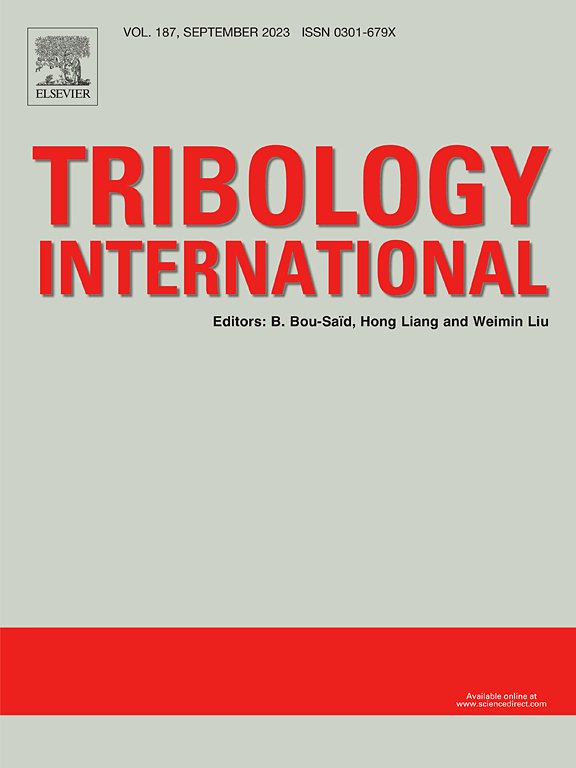Atomic-scale insights into the mechanical and tribological properties of graphullerene
IF 6.1
1区 工程技术
Q1 ENGINEERING, MECHANICAL
引用次数: 0
Abstract
Graphullerene (GF) as an emerging two-dimensional nanomaterial exhibits excellent flexibility properties and superlubricity potential, but current research on its mechanical and tribological properties still lacks in-depth insights from the microscopic scale. Herein, the mechanical strength of GF was explored and its tribological mechanisms as a lubricant additive in fluid and boundary lubrication states were revealed by indentation, tensile, and friction molecular dynamics simulations using graphene (GR) as a comparative object. The results revealed that compared with GR, covalent bond mixed hybridization reduced the mechanical strength of GF, but the robust spherical structure enhanced its bending stiffness. Under fluid lubrication, GR promoted adsorption film formation and rapid flow to induce low-shear strength solid-liquid interfacial slip. GF inhibited this characteristic and thus induced liquid-liquid interlayer slip with high frictional resistance. Under boundary lubrication, GR exhibited superior tribological performance compared to GF, with the bilayer outperforming the monolayer. This was attributed to the high bending stiffness of GF inhibiting the bending deformation releasing stresses and thus deteriorating the mechanical contact with the asperity. However, friction-induced interlayer slip of bilayer nanoparticles with low shear strength. This study provides valuable insights into the mechanical and tribological properties of GF.
石墨烯的机械和摩擦学性能的原子尺度的见解
石墨烯(Graphullerene,GF)作为一种新兴的二维纳米材料,具有优异的柔韧性能和超润滑潜力,但目前对其机械和摩擦学性能的研究仍缺乏微观尺度的深入洞察。本文以石墨烯(GR)为对比对象,通过压痕、拉伸和摩擦分子动力学模拟,探讨了 GF 的机械强度及其作为润滑添加剂在流体和边界润滑状态下的摩擦学机理。结果表明,与石墨烯相比,共价键混合杂化降低了 GF 的机械强度,但坚固的球形结构增强了其弯曲刚度。在流体润滑条件下,GR 可促进吸附膜的形成和快速流动,从而引起低剪切强度的固液界面滑移。GF 则抑制了这一特性,从而诱发了具有高摩擦阻力的液-液层间滑移。在边界润滑条件下,GR 的摩擦学性能优于 GF,双层摩擦学性能优于单层摩擦学性能。这归因于 GF 的高弯曲刚度抑制了弯曲变形释放应力,从而恶化了与表面的机械接触。然而,双层纳米粒子的摩擦引起的层间滑移具有较低的剪切强度。这项研究为了解 GF 的机械和摩擦学特性提供了宝贵的见解。
本文章由计算机程序翻译,如有差异,请以英文原文为准。
求助全文
约1分钟内获得全文
求助全文
来源期刊

Tribology International
工程技术-工程:机械
CiteScore
10.10
自引率
16.10%
发文量
627
审稿时长
35 days
期刊介绍:
Tribology is the science of rubbing surfaces and contributes to every facet of our everyday life, from live cell friction to engine lubrication and seismology. As such tribology is truly multidisciplinary and this extraordinary breadth of scientific interest is reflected in the scope of Tribology International.
Tribology International seeks to publish original research papers of the highest scientific quality to provide an archival resource for scientists from all backgrounds. Written contributions are invited reporting experimental and modelling studies both in established areas of tribology and emerging fields. Scientific topics include the physics or chemistry of tribo-surfaces, bio-tribology, surface engineering and materials, contact mechanics, nano-tribology, lubricants and hydrodynamic lubrication.
 求助内容:
求助内容: 应助结果提醒方式:
应助结果提醒方式:


